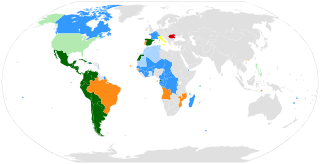
The Romance languages are the modern languages that evolved from Vulgar Latin between the third and eighth centuries and that form a subgroup of the Italic languages within the Indo-European language family.
The phonology of Portuguese can vary between dialects, in extreme cases leading to some difficulties in intelligibility. This article focuses on the pronunciations that are generally regarded as standard. Since Portuguese is a pluricentric language, and differences between European Portuguese (EP) and Brazilian Portuguese (BP) can be considerable, both varieties are distinguished whenever necessary.
French phonology is the sound system of French. This article discusses mainly the phonology of Standard French of the Parisian dialect. Notable phonological features include its uvular r, nasal vowels, and three processes affecting word-final sounds: liaison, a specific instance of sandhi in which word-final consonants are not pronounced unless they are followed by a word beginning with a vowel; elision in which certain instances of (schwa) are elided and enchaînement (resyllabification) in which word-final and word-initial consonants may be moved across a syllable boundary, with syllables crossing word boundaries:
Santiago Creole is the name given to the Cape Verdean Creole spoken mainly on Santiago Island of Cape Verde. It belongs to the Sotavento Creoles branch of Creole.
The phonological system of the Polish language is similar in many ways to those of other Slavic languages, although there are some characteristic features found in only a few other languages of the family, such as contrasting retroflex and palatal fricatives and affricates, and nasal vowels. The vowel system is relatively simple, with just six oral monophthongs and two nasals, while the consonant system is much more complex.
São Vicente Creole is the name given to the variant of Cape Verdean Creole spoken mainly in the São Vicente Island of Cape Verde. It belongs to the Barlavento Creoles branch. This form of the Cape Verdean Creole has about 80,000 to 100,000 speakers primarily in the São Vicente island, but also in a large segment of the Cape Verdean diaspora population. It is the second most widely spoken Cape Verdean creole. It has produced literature from a lot of writers and musicians including Sergio Frusoni and many more.
The following is a list of common non-native pronunciations that English speakers make when trying to speak foreign languages. Many of these are due to transfer of phonological rules from English to the new language as well as differences in grammar and syntax that they encounter.
Portuguese orthography is based on the Latin alphabet and makes use of the acute accent, the circumflex accent, the grave accent, the tilde, and the cedilla to denote stress, vowel height, nasalization, and other sound changes. The diaeresis was abolished by the last Orthography Agreement. Accented letters and digraphs are not counted as separate characters for collation purposes.
Fogo Creole is the name given to the variant of Cape Verdean Creole spoken mainly in the Fogo of Cape Verde. It has around 50,000 speakers or nearly 5% of Cape Verdean Creole speakers including the diaspora's second language speakers. It belongs to the Sotavento Creoles branch. The rankings of this form of Cape Verdean Creole is fourth after Santo Antão and ahead of Sal.
Maio Creole is the name given to the variant of Cape Verdean Creole spoken mainly in the Maio Island of Cape Verde. It belongs to the Sotavento Creoles branch. It numbers the entire island population which includes a small part which also speaks Portuguese, in 2005, the percentage was 1.36%.
Boa Vista Creole is the name given to the variant of Cape Verdean Creole spoken mainly in the Boa Vista Island of Cape Verde. It belongs to the Barlavento Creoles branch. The speakers of this form of Cape Verdean Creole are 5,000 in 2007 and is the least spoken form of Creole in the language. Literature is rarely recorded but one of the speakers who was born on the island is Germano Almeida.
Sal Creole is the name given to the variant of Cape Verdean Creole spoken mainly in the island of Sal of Cape Verde. It belongs to the Barlavento Creoles branch. The speakers of this form of Cape Verdean Creole are 15,000.
São Nicolau Creole is the variant of Cape Verdean Creole spoken mainly in the São Nicolau Island of Cape Verde. It belongs to the Barlavento Creoles branch. The speakers of this form of Cape Verdean Creole are 15,000 and it is the fifth most spoken form of Creole in the language. Literature is rarely recorded but the form of the Capeverdean Creole has been recorded in music.
The Alfabeto Unificado para a Escrita do Caboverdiano, commonly known as ALUPEC, is the alphabet that was officially recognized by the Cape Verdean government to write Cape Verdean Creole.
The phonology of Sesotho and those of the other Sotho–Tswana languages are radically different from those of "older" or more "stereotypical" Bantu languages. Modern Sesotho in particular has very mixed origins inheriting many words and idioms from non-Sotho–Tswana languages.
The traditional English pronunciation of Latin, and Classical Greek words borrowed through Latin, is the way the Latin language was traditionally pronounced by speakers of English until the early 20th century.
This article is about the phonology of the Lithuanian language. Lithuanian has a phonemic inventory consisting of eleven vowels and 45 consonants, including 22 pairs of consonants distinguished by the presence or absence of palatalization.
This article discusses the phonological system of Standard Bulgarian. Most scholars agree that contemporary Bulgarian has 45 phonemes but different authors place the real number of Bulgarian phonemes between 42 and 47, depending on whether one includes or excludes phonemes which appear primarily only in borrowed foreign words.
This article describes the phonology of the Occitan language.


